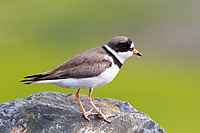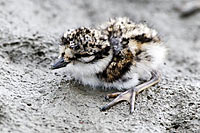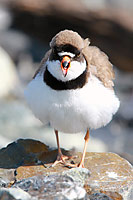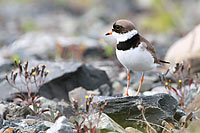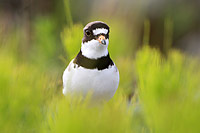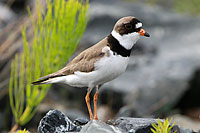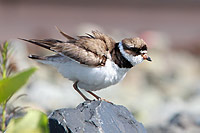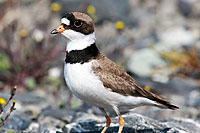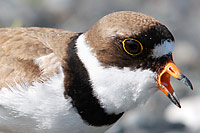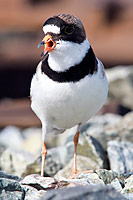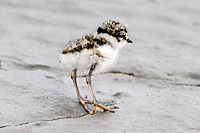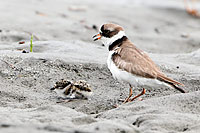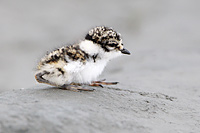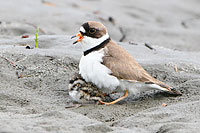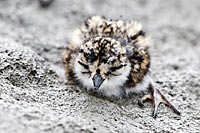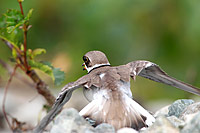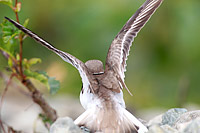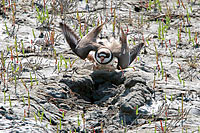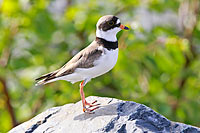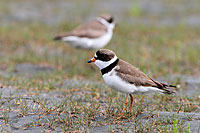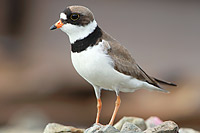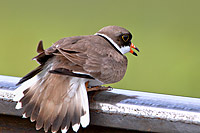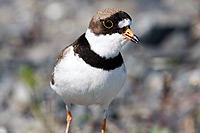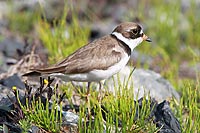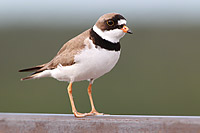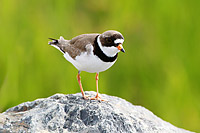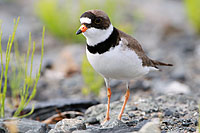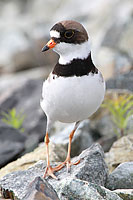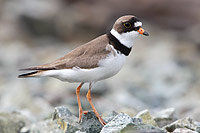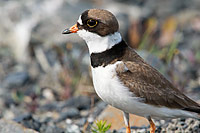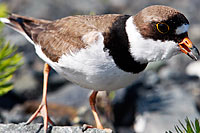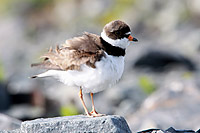 |
~ Semipalmated Plovers in Alaska ~
| |
|
|
|
Semipalmated Plovers are small migratory shorebirds commonly found in North & South America. They have a short neck and
slender orange legs with partly webbed feet. Adults wearing their breeding plumage have a white belly, brown wings and
a distinctive single black band around their neck. The bill is orange with a black tip.
|
|
|
Their non-breeding plumage has a slightly less contrasty appearance with the neck band turning brown from black.
|
|
|
|
|
|
|
Common Names:
Scientific Name:
|
Semipalmated Plover
Charadrius semipalmatus
|
Class:
Family:
|
Aves
Charadriidae
|
Breeding Range:
Winter Range:
|
Alaska, Northern Canada
Coastal regions of N. & S. America
|
Length:
Weight:
|
13 to 15 cm (in Alaska)
40 to 50 grams
|
| |
Unlike Sandpipers which gather in huge flocks during their migrations, this type of shorebirds migrates in relatively small flocks.
|
|
|
Semipalmated Plover Migration & Habitat |
|
|
Semipalmated Plovers spend the winter months in the coastal regions of North and South America. During the spring migration in April-May,
most fly across North America to reach their breeding grounds in Alaska and Northern Canada. Males arrive at their destination
several days before the females, allowing them to establish their nesting sites before pairing.
|
|
|
|
|
|
|
|
|
Their favorite breeding locations are near lakes, marshes and streams.
The fall migration usually begins in July or August when they return to their coastal habitat.
|
|
|
Semipalmated Plover Nesting |
|
|
|
|
Semipalmated Plovers build their nest in a small depression on the ground. The female usually lays 3 to 4 eggs and raises a single brood every season.
The eggs are approximately 3 cm long, off-white color with dark blotches of various sizes.
|
|
|
|
|
Plover Chick
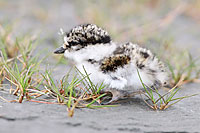 |
|
|
|
|
|
Both male and female Plovers take turns incubating the eggs and attending to the chicks after they hatch.
The Plover chicks are extremely small and initially weigh just a few grams.
|
|
|
|
|
|
Plover Distraction Display |
|
|
|
|
|
|
When a predator is within sight, Semipalmated Plovers may pretend to be injured and in distress by spreading and shaking their wings, as if they were broken.
|
|
This distraction display is nothing but a stragegy to get the attention of the predator and lure it away from a nearby nest or chick. The
broken wing display makes the predator think that the Plover would be an easy prey.
|
|
Broken Wing Display
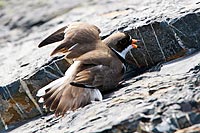 |
|
|
|
|
Some miscellaneous photos of Semipalmated Plovers in South Central Alaska.
|
|
|
|
|
Plover and Chick
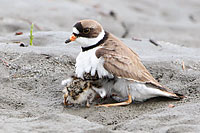 |
|
|
|
|
|
|
|
A Semipalmated Plover proudly displays its breeding plumage in early summer (alternate plumage): the single neck band is dark black.
In winter, the neck band turns brown (basic plumage).
|
|
|
Plovers are difficult to photograph due to their relatively small size and because they tend to move extremely fast.
|
|
|
|
|
|
Semipalmated Plover in Coastal Alaska |
|
|
In this region of Alaska, a Semipalmated Plover is spotted near the inlet in late Spring.
|
|
Go to the Moon & Get the Best Pictures
...Smile... ' Click! '

[email protected]
© Copyright Go2Moon, Alaska


